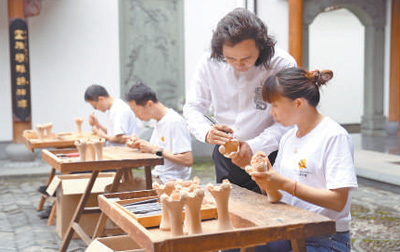Dongyang wood carving shines with new vitality in E China's Zhejiang
Dongyang wood carving, which originated in Dongyang city of east China's Zhejiang Province, dates back more than 1,000 years. It was listed in the first batch of the country's national intangible cultural heritages in 2006.

Huang Xiaoming, a national-level master of arts and crafts, instructs an apprentice on carving a floral vessel for the 19th Asian Games. (Photo courtesy of Huang Xiaoming)
Local craftspeople have passed down the traditional wood carving art through innovation and blazed a development path for the intangible cultural heritage, injecting fresh vitality into the traditional craft.
Dongyang wood carving is known for its unique craftsmanship and exquisite artistry. Dongyang is home to 11 national-level masters of arts and crafts and 60 provincial-level ones.
Lu Guangzheng, in his late 70s, is a national-level inheritor of Dongyang wood carving. Lu was admitted to the wood carving technical school in Dongyang when he was 13 years old. Today, he still actively participates in the creation of wood carving works.
"Wood carving is an art form that requires comprehensive knowledge, encompassing fields such as architecture, fine arts, and music. So, I always advise my apprentices to not only master the fundamental skills of wood carving, but also learn from various disciplines," Lu said.
The artist added that the further development of the wood carving industry relies on not only experienced artisans, but, more importantly, the younger generation.
The floral vessel for the 19th Asian Games in Hangzhou, capital of Zhejiang, was designed by Huang Xiaoming, a national-level master of arts and crafts, and made of wood exquisitely carved via the craftsmanship of Dongyang wood carving.

Photo shows a wood carving work of Lu Guangzheng, a national-level inheritor of Dongyang wood carving. (Photo courtesy of Lu Guangzheng)
The Grand Canal Red Sandalwood Museum in Hangzhou, which is open to the public free of charge, has become a site for visitors to closely experience and understand Dongyang wood carving and rosewood culture.
"The aim of establishing the museum is to make the wood carving culture reach a wider audience," said Li Xiaodong, founder of the museum. Since its opening, the museum has received over 100,000 tourist visits.
Dongyang wood carving is inseparable from rosewood. In the 1980s, rosewood furniture gained in popularity.
Thanks to the rise of the Dongyang wood carving and rising levels of consumption in the Yangtze River Delta region, many wood carving artisans who worked outside Dongyang returned to their hometown to explore potential business opportunities, including Zhang Xiangrong, general manager of a rosewood furniture company in the city.
In 1998, Zhang, who had worked in south China's Guangdong for 10 years, returned to Dongyang to set up a rosewood furniture factory.
To produce rosewood furniture that is more in line with traditional Chinese aesthetics, Zhang and his carpenters have made no less than 10 trips to the Palace Museum, which houses many pieces of antique furniture.
According to Zhang, this reflects the Dongyang wood carving artisans' inheritance of traditional culture. "It's not enough to just focus on wood carvings; we also need to carry on the culture behind it," Zhang said.
Wang Haiyang, general manager of another rosewood furniture company in Dongyang, paid attention to the personalized needs of consumers according to changes in the consumption structure.
To this end, his company has provided customized whole-home furnishing solutions. "This requires us to explore cultural elements, especially the cultural connotations of Dongyang wood carving, which lay the foundation for the development of the industry," Wang said.
At its peak, Dongyang was home to over 3,000 rosewood enterprises. Nowadays, industries related to Dongyang wood carving operate on a more standardized approach. By the end of 2023, the total output value of the rosewood industry chain in Dongyang reached 77 billion yuan ($10.64 billion), with the sector providing employment opportunities for over 100,000 people.
The Dongyang economic development zone has become an industrial park that integrates the creative design of wood carving art, production and sales, exhibition, leisure and tourism. The industrial park has gathered 37 masters of arts and crafts at the provincial level and above.

Photo shows a scene of the Dongyang wood carving industrial park. (Photo courtesy of the media convergence center of Dongyang city)
Chen Guohua is a provincial-level master of arts and crafts who runs an art gallery in the industrial park. To him, the industrial park attracts wood carving artisans, providing more opportunities for exchanges. Every year, the industrial park holds 100 themed activities, including experiencing intangible cultural heritage and wood carving culture, which further expands the cultural influence of Dongyang wood carving.
"We focus on entrepreneurship and talent training in the wood carving and rosewood industry," said Li Aizhong, director of the management committee of the Dongyang economic development zone.
The industrial park has also signed an agreement with Zhejiang Guangsha Vocational and Technical University of Construction to cultivate a professional talent team for the traditional wood carving industry.
Photos
 People fly Kongming lanterns to celebrate New Year of calendar of Dai ethnic group
People fly Kongming lanterns to celebrate New Year of calendar of Dai ethnic group People savor beautiful sights of spring flowers across China
People savor beautiful sights of spring flowers across China Improved ecological environment attracts common cranes to Karamay, NW China's Xinjiang
Improved ecological environment attracts common cranes to Karamay, NW China's Xinjiang Protection of Erhai Lake in SW China's Yunnan yields economic benefits
Protection of Erhai Lake in SW China's Yunnan yields economic benefits
Related Stories
- In pics: Wood carving works from China’s Fujian tell China stories to world
- 72-year-old wood sculptor makes model of Luding Bridge using traditional technique
- Skilled craftsman devotes 37 years to become master of traditional wood carving artform in E China’s Anhui
- Wood carving: time-honored handicraft of Kazakh ethnic minority in Xinjiang
- In Pics: Wood carving inheritor in SE China’s Jiangxi
Copyright © 2024 People's Daily Online. All Rights Reserved.





